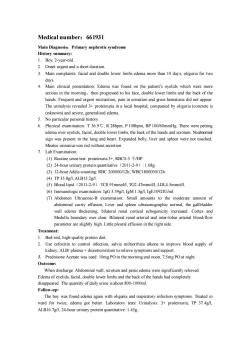《儿科学》课程作业习题(典型病例)06 nephrotic syndrome-2

Medical number: 661931Main Diagnosis: Primary nephrotic syndromeHistory summary:Boy, 2-year-old2.Onset urgent and a short durationMain complaints:facial anddoublelower limtnore than 10 days,days4.Main clinical presentation: Edema was found on the patient's eyelids which were moreserious in the morning, then progressed to his face, double lower limbs and the back of thehands.Frequent and urgent micturition, pain in urination and goss hematuria did not appear.The urinalysis revealed 3+ proteinuria in a local hospital, companied by oliguria (concrete isunknown)andsevere,generalizededema5.No particular personal history6Physical examination:36.9℃R28bpm,P108bpmBP100/60mmHg.There were pettinedema over eyelids, facial, double lower limbs, the back of the hands and scrotum. Noabnomalne lung and heart.Expanded belly, liver and spleen were not touchedsigrMeawas red without secretiorLabExaminatio(I) Routine urine test proteinuria3+, RBCO-3 个/HP(2) 24-hour urinary protein quantitative (2011-2-9) : 1.68g.(3)12-hourAddiscounting:RBC200000/12h,WBC1800000/12h(4) TP 35.8g/L, ALB15.2g/l(5) Blood lipid (2011-2-9) :TC8.91mmol/l, TG2.47mmol/l,LDL4.5mmol/(6)Immunologicexamination:IgG3.59g/l,IgM1.3g/l,IgE1092IU/ml(7) Abdomen Ultrasonic-B examination: Small amounts to the moderate amount ofabdominal cavity effusion, Liver and spleen ultrasonographic normal, the gallbladdewall edema thickening, bilateral renal cortical echogenicity increased. Cortex andMedullaboary owe clear. Bilateral renal arterial and inter-lobar arterial blood-flowparameter areslightly high. Littlepleural effusion intheright sideTreatment:1.Bed-rest, high-quality protein diet.Use cefoxitin tentrol infection, salvia miltirrhiza alkone to improve blood supply ofkidney,ALB/ plasma + diureticmixture to relieve symptoms and suppor3.Prednisone Acetate was used: 10mg POin the morning and noon, 7.5mg POat nightOutcomeWhen discharge:Abdominal wall, scrotum and penis edema weresignificantly relievedEdema of eyelids, facial, double lower limbs and the back ofthe hands had completelydisappeared.The quantity of daily urine is about 800-1000mlFollow-up:The boy wasfound edema again with oliguria and respiratory infection symptoms. Treated inward for twice, edema got beter. Laboratory tests: Urinalysis: 3+ proteinuria, TP 37.4g/l,ALB16.7g/; 24-hour urinary protein quantitative: 1.45g
Medical number:661931 Main Diagnosis:Primary nephrotic syndrome History summary: 1. Boy, 2-year-old. 2. Onset urgent and a short duration. 3. Main complaints: facial and double lower limbs edema more than 10 days, oliguria for two days. 4. Main clinical presentation: Edema was found on the patient’s eyelids which were more serious in the morning,then progressed to his face, double lower limbs and the back of the hands. Frequent and urgent micturition, pain in urination and gross hematuria did not appear. The urinalysis revealed 3+ proteinuria in a local hospital, companied by oliguria (concrete is unknown) and severe, generalized edema. 5. No particular personal history. 6. Physical examination: T 36.9℃, R 28bpm, P 108bpm, BP 100/60mmHg. There were petting edema over eyelids, facial, double lower limbs, the back of the hands and scrotum. No abnormal sign was present in the lung and heart. Expanded belly, liver and spleen were not touched. Meatus urinarius was red without secretion. 7. Lab Examination: (1) Routine urine test: proteinuria 3+, RBC0-3 个/HP. (2) 24-hour urinary protein quantitative(2011-2-9): 1.68g. (3) 12-hour Addis counting: RBC 200000/12h, WBC1800000/12h. (4) TP 35.8g/l, ALB15.2g/l. (5) Blood lipid(2011-2-9):TC8.91mmol/l, TG2.47mmol/l, LDL4.5mmol/l. (6) Immunologic examination: IgG 3.59g/l, IgM 1.3g/l, IgE1092IU/ml. (7) Abdomen Ultrasonic-B examination: Small amounts to the moderate amount of abdominal cavity effusion, Liver and spleen ultrasonographic normal, the gallbladder wall edema thickening, bilateral renal cortical echogenicity increased. Cortex and Medulla boundary owe clear. Bilateral renal arterial and inter-lobar arterial blood-flow parameter are slightly high. Little pleural effusion in the right side. Treatment: 1. Bed-rest, high-quality protein diet. 2. Use cefoxitin to control infection, salvia miltiorrhiza alkone to improve blood supply of kidney; ALB/ plasma + diureticmixture to relieve symptoms and support. 3. Prednisone Acetate was used: 10mg PO in the morning and noon, 7.5mg PO at night. Outcome: When discharge: Abdominal wall, scrotum and penis edema were significantly relieved. Edema of eyelids, facial, double lower limbs and the back of the hands had completely disappeared. The quantity of daily urine is about 800-1000ml. Follow-up: The boy was found edema again with oliguria and respiratory infection symptoms. Treated in ward for twice, edema got better. Laboratory tests: Urinalysis: 3+ proteinuria; TP 37.4g/l, ALB16.7g/l; 24-hour urinary protein quantitative: 1.45g
按次数下载不扣除下载券;
注册用户24小时内重复下载只扣除一次;
顺序:VIP每日次数-->可用次数-->下载券;
- 《儿科学》课程作业习题(复习题)01 questions of children healthcare.doc
- 《儿科学》课程作业习题(复习题)02 questions of neonatal diseases.doc
- 《儿科学》课程作业习题(复习题)05 questions of blood disorders.doc
- 《儿科学》课程作业习题(复习题)04 questions of circulatory system.doc
- 《儿科学》课程作业习题(复习题)03 questions of respiratory diseases.doc
- 《儿科学》课程作业习题(复习题)06 questions of nervous system.doc
- 《儿科学》课程作业习题(复习题)10 questions of infectious diseases.doc
- 《儿科学》课程作业习题(复习题)09 questions of endocrine disorders.doc
- 《儿科学》课程作业习题(复习题)07 questions of urinological system.doc
- 《儿科学》课程作业习题(复习题)08 questions of immune system.doc
- 《儿科学》课程教学资源(授课教案)12 Acute Glomerulonephritis,Nephrotic Syndrome.doc
- 《儿科学》课程教学资源(授课教案)11 Acute Convulsion in Children.doc
- 《儿科学》课程教学资源(授课教案)13 Immunodeficiency.doc
- 《儿科学》课程教学资源(授课教案)10 Nutritional Iron Deficiency Anemia.doc
- 《儿科学》课程教学资源(授课教案)15 Growth Hormone Deficiency.doc
- 《儿科学》课程教学资源(授课教案)14 Congenital Hypothyroidism.doc
- 《儿科学》课程教学资源(授课教案)17 Varicella.doc
- 《儿科学》课程教学资源(授课教案)16 Measles.doc
- 《儿科学》课程教学资源(授课教案)19 Tuberculosis Meningitis.doc
- 《儿科学》课程教学资源(授课教案)20 Toxic Bacillary Dysentery.doc
- 《儿科学》课程作业习题(典型病例)06 anute nepheritis-1.doc
- 《儿科学》课程作业习题(典型病例)08 diarrhea.doc
- 《儿科学》课程作业习题(典型病例)03 congenital heart disease-VSD.doc
- 《儿科学》课程作业习题(典型病例)04 iron deficiency anemia.doc
- 《儿科学》课程作业习题(典型病例)05 purulent meningitis.doc
- 《儿科学》课程作业习题(典型病例)07 congenital hypothyroidism.doc
- 《儿科学》课程作业习题(典型病例)03 congenital heart disease-TOF.doc
- 《儿科学》课程作业习题(典型病例)01 ABO incompatibility of neonates.doc
- 《儿科学》课程作业习题(典型病例)02 pneumonia.doc
- 《儿科学》课程作业习题(试卷和答案)双语试卷C卷(试题).doc
- 《儿科学》课程作业习题(试卷和答案)双语试卷B卷(试题).doc
- 《儿科学》课程作业习题(试卷和答案)双语试卷B卷(答案).doc
- 《儿科学》课程作业习题(试卷和答案)双语试卷C卷(答案).doc
- 《儿科学》课程作业习题(试卷和答案)双语试卷A卷(试题).doc
- 《儿科学》课程作业习题(试卷和答案)双语试卷A卷(答案).doc
- 《儿科学》课程教学课件(PPT讲稿)07 新生儿缺氧缺血性脑病 Hypoxic-ischemic Encephalopathy(HIE).pptx
- 《儿科学》课程教学课件(PPT讲稿)06 新生儿败血症 Neonatal Septicemia.pptx
- 《儿科学》课程教学课件(PPT讲稿)21 Chronic Gastritis in Children.pptx
- 《儿科学》课程教学课件(PPT讲稿)20 Toxic Bacillary Dysentery.pptx
- 《儿科学》课程教学课件(PPT讲稿)27 Inflammation Causes Cholesterol Redistribution by Diverting Cholesterol from Circulation to Tissue Tompartments.pptx
